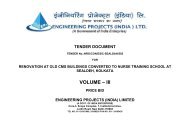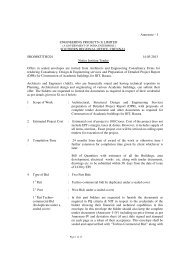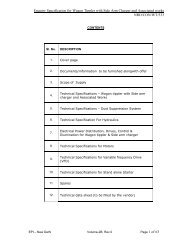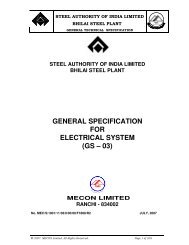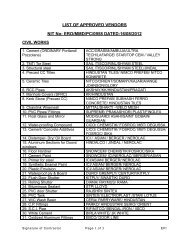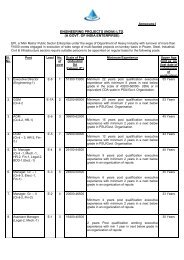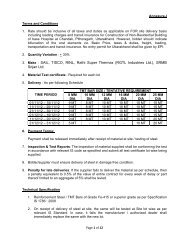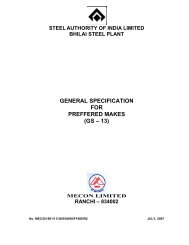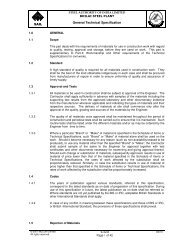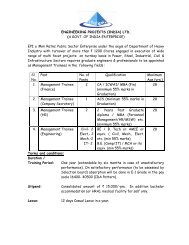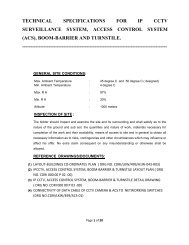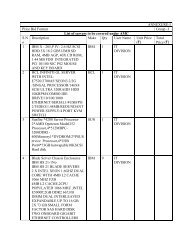4 General Technical Specification of Bhilai Steel Plant, SAIL ...
4 General Technical Specification of Bhilai Steel Plant, SAIL ...
4 General Technical Specification of Bhilai Steel Plant, SAIL ...
You also want an ePaper? Increase the reach of your titles
YUMPU automatically turns print PDFs into web optimized ePapers that Google loves.
© 2007 MECON Limited<br />
All rights reserved<br />
<strong>General</strong> <strong>Technical</strong> <strong>Specification</strong><br />
c) Installation <strong>of</strong> gas pipes with air pipes to gas consumer units is allowed to be laid<br />
in channels.<br />
d) Channels with gas pipes should not cross other channels, In case, it is<br />
unavoidable, air tight tie-plate should be made and gas pipe should be placed in<br />
casing. Ends <strong>of</strong> casing should be taken out beyond the limit <strong>of</strong> tie-plate by 300<br />
mm at both ends.<br />
e) Channels should have provisions for natural ventilation.<br />
12. Gas pipes in buildings should be located at places convenient for servicing,<br />
inspection and repair. It is not allowed to lay gas pipes at places where there are<br />
chances <strong>of</strong> damage due to shop transport.<br />
13. For gas lines installed in hot zone, it is recommended to provide protection<br />
against overheating <strong>of</strong> gas pipes.<br />
14. It is allowed to fasten gas pipes to frames <strong>of</strong> furnaces, boilers and other units<br />
provided these frames are checked for strength by calculations.<br />
15. Gas pipes are not allowed to pass through buildings producing or having<br />
materials liable to explode or burn and building <strong>of</strong> power distributing devices and<br />
substations and ventilation chambers and through buildings, in which gas pipe<br />
may be damaged by intensive corrosion.<br />
16. Gas pipes should not cross ventilation doors, air exhauster, flue pipes and also<br />
gas pipes should not be installed in insufficiently ventilated space and in<br />
underground buildings.<br />
17. Installation <strong>of</strong> high pressure gas pipes below main working platforms <strong>of</strong> shops is<br />
not permitted.<br />
18. Gas pipes along bridges should be made <strong>of</strong> seamless pipe and laid in the open<br />
at a horizontal distance <strong>of</strong> one metre from ends <strong>of</strong> pavements for passing <strong>of</strong><br />
people and it should be within reach for servicing. Supporting elements <strong>of</strong> the<br />
bridge should be accordingly checked for loads from gas pipes. Laying <strong>of</strong> gas<br />
pipes in channels <strong>of</strong> bridges is not allowed. All welding joints <strong>of</strong> gas pipes in the<br />
area <strong>of</strong> their attachment to bridge should be radiographed.<br />
19. Gas pipes passing through walls, ceilings, and other structures <strong>of</strong> buildings <strong>of</strong><br />
construction shall be encased in a steel pipe having inside dia at least 50 mm<br />
more than that <strong>of</strong> the oxygen pipe. The Gas pipe shall have no joints in the<br />
section at such crossings. The gap between the gas pipe and the outer pipe<br />
shall be filled with non/inflammable material, but allowing vertical and horizontal<br />
movement.<br />
20. The laying <strong>of</strong> moist fuel gas pipelines shall be as per IPPS: 1-06-014-95<br />
21 Pressure pipe work for gases and liquid fuels generally shall be routed<br />
overhead. All overhead interplant pipe work to be routed such that they will have<br />
a minimum clearance <strong>of</strong> 6.0m between bottom <strong>of</strong> supporting structures / pipes<br />
and road / railway track. The pipelines laid over hot tracks shall have a minimum<br />
clearance <strong>of</strong> 10.0m. In case, protective shields are used in these places, this<br />
clearance may be reduced to 6.0m. Buried pipes, wherever laid, shall be<br />
provided with a minimum earth covering <strong>of</strong> 1200mm in areas subject to<br />
Gases & Liquid Fluids<br />
Page 3 <strong>of</strong> 51<br />
GS-02



